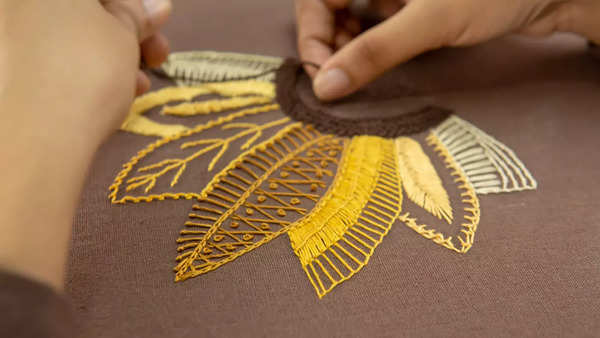Origin and history
Khneng embroidery has been passed down through generations among the Khasi women, preserving their rich cultural identity.The word “Khneng” translates to “cloth” or “textile” in the Khasi language, emphasizing the primary medium of this craft. The embroidery is traditionally done on cotton fabric, which is often dyed using natural colors, reflecting the region’s eco-friendly approach.
Technique
The distinctive feature of Khneng embroidery lies in its geometric patterns and vibrant colors. The embroidery is characterized by intricate stitchwork, including straight stitches, cross-stitches, and the use of bright threads. Traditional motifs often include diamonds, squares, and zigzag patterns. The stitches are meticulously crafted, creating a harmonious blend of colors and shapes on the fabric.
Symbolism and cultural significance
Khneng embroidery is not just a form of artistic expression but also carries deep cultural symbolism. It is often used to create traditional garments worn during significant cultural events, ceremonies, and festivals. The embroidered designs are symbolic representations of the community’s beliefs, values, and connection to nature.
The craft is also passed down as a form of familial heritage, with older generations teaching the younger ones the art of Khneng embroidery. The intricate patterns often hold stories and narratives within the stitches, making each piece a unique reflection of the artisan’s creativity and cultural identity.
Handloom and craft from different regions are on display at the handloom fair
Traditional attire
Khneng embroidery plays a crucial role in the creation of traditional Khasi attire. Women often wear dresses known as “Jainsem,” which are adorned with the elaborate embroidery. The colors and patterns chosen for the embroidery are carefully selected to represent specific occasions, rites of passage, or personal milestones in the wearer’s life.

Preservation and challenges
While Khneng embroidery continues to thrive within the Khasi community, there are challenges to its preservation. The influx of modernization and changing lifestyles has led to a decline in the number of artisans practicing this traditional craft. Efforts are being made by cultural organizations, NGOs, and the government to promote and sustain Khneng embroidery by organizing workshops, providing training, and creating platforms for artisans to showcase their work.
Economic impact
Apart from its cultural significance, Khneng embroidery also serves as a source of income for many Khasi women. Handcrafted items featuring Khneng embroidery, such as garments, accessories, and home decor, are gaining recognition in the market. This not only provides economic opportunities for the artisans but also contributes to the preservation of this unique cultural heritage.
Thumb Image Courtesy: NESFAS

